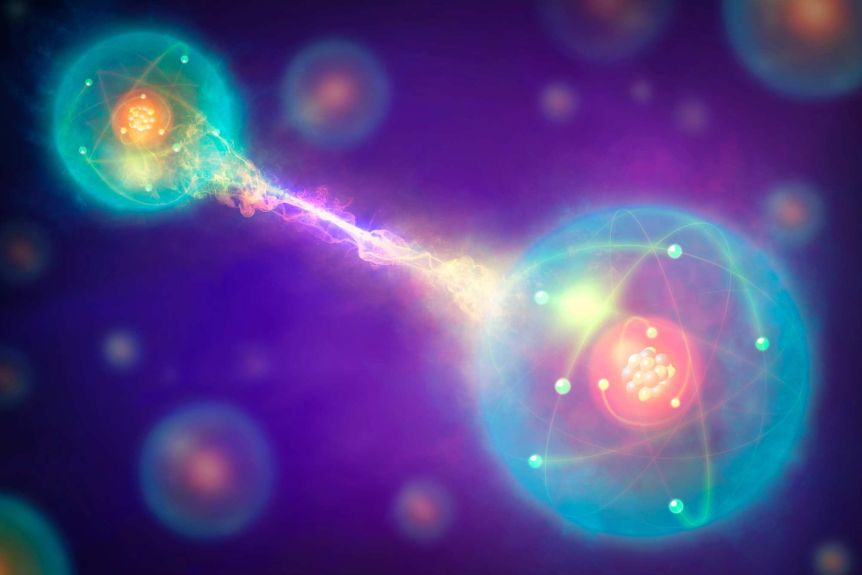Chinese scientists have transmitted the quantum version of computer memory between two entangled clouds of atoms over 50 kilometres.
The feat, which was achieved using standard fibre optic cables, breaks through the 1.3-kilometre barrier achieved by previous quantum memory experiments.
Entanglement — dubbed “spooky action at a distance” by Einstein — is a cornerstone of quantum physics.
The ability to manipulate the spin, position and momentum of two — or more — entities separated by distance underlies future technologies such as secure communication systems.
The scientists say the experiment, published today in the journal Nature, is a step towards building a quantum internet.
The main significance of this paper lies in extending the entangling distance in [optical] fibre between quantum memories to the city scale,” said Jian-Wei Pan, of the University of Science and Technology of China (USTC),
The team’s work is an “absolutely formidable achievement,” commented Ben Buchler, a physicist at the Australian National University.
So what did they do?
Quantum memory is similar to memory in traditional computers except that a qubit — like Schrodinger’s cat — can be two states (0 and 1) at the same time or somewhere in between.
Qubits are usually encoded and sent on things like particles of light (photons) and stored on atoms.
Sending quantum information over enormous distances via optic fibre networks is extremely challenging.
Traditional networks use amplifiers at regular points to boosts the signal, but qubits can’t be copied so particles get scattered and lost.
“The main technology advance lies in developing an efficient atom-photon entanglement source that is suitable for low-loss transmission in fibres,” said study co-author Dr Xiao-Hui Bao also of USTC.
The scientists encoded information onto two clouds of a billion atoms then extracted a photon from each cloud.
They then converted the wavelength of the photons from near-infrared so they could be sent through standard optical fibres.
The photons were then sent to a central point in the network to be read.
The ability to detect and read the properties of the photons together at the central point indicate the atoms are entangled.
started with two atom clouds that weren’t entangled, but by making this joint measurement [they’re] forcing entanglement into the two atom clouds,” Dr Buchler explained.
The experiments transmitted quantum memories between two locations 22 kilometres apart, as well as through a 50-kilometre-long coiled fibre.
Optical fibre vs satellite networks
It’s not the first time Professor Jian-Wei’s group has created a quantum record.
In 2017, they sent entangled photons between Earth and satellites — a distance of up to 1,200 kilometres.
While the latest experiments don’t match the distance achieved by satellite, the two technologies serve different purposes, Professor Jian-Wei said.
“The satellite-based method suits better for the scenario of large-scale applications in which fibre connection is not allowed,” he said.
But the atom-photon entanglement system could overcome the quantum repeater problem in ground-based fibre systems to reduce loss over distances.
The idea is that instead of trying to transmit information over very long distances, the information is sent via a network of photon-atom entanglement systems linked to each other.
“If we [detect the photons], the connection between each segment will be very efficient, if storage time of the memories is sufficiently long,” Dr Xiao-Hui said.
Although satellite was “definitely winning” the distance records, Dr Buchler said quantum repeaters could distribute memory in a controlled way and enable synchronised networks.
“If you’ve just got photons flying around its very hard to delay them so that they arrive at the right place at the right time,” Dr Buchler said.
“But if you have a system that you can control where you push a button to get the photons out on demand that’s the advantage of these memory systems.”
So when will we see a quantum internet?
While the experiment is “super-amazing” Dr Buchler said it’s still a long way from being viable in the real world.
At the moment, he said, the quality and rate of entanglement is still very low.
“They’re only getting one photon every 150 seconds that work,” Dr Buchler said.
Professor Jian-Wei agreed much more work was needed to improve the system.
“Nevertheless, some prototype of small-scale quantum network of memories will be seeable in several years,” he predicted.













![Hotstar Premium Cookies 2019 [*100% Working & Daily Updated*] Hotstar Premium Cookies 2019 [*100% Working & Daily Updated*]](https://tahav.com/wp-content/uploads/2019/11/Hotstar-Premium-Cookies-Free-100x70.jpg)



